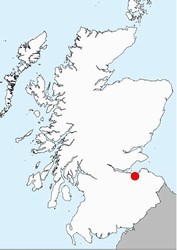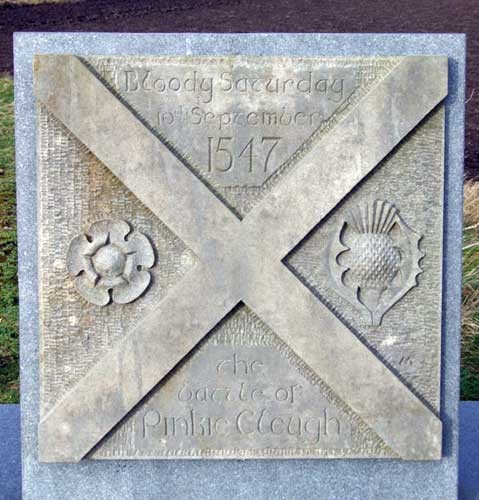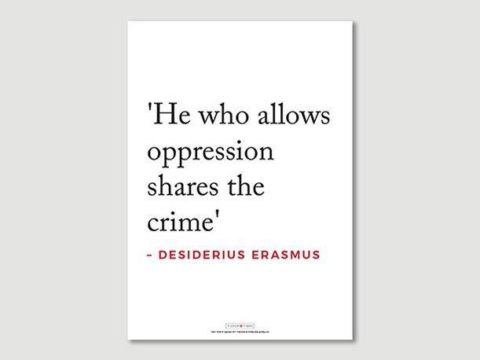1547 Battle of Pinkie Cleugh
Chapter 5 : The Main Battle
Somerset left London on 22nd August 1547, and crossed the border at Berwick on 1st September. He continued to keep close to the coast, capturing and destroying Dunglas, Innerwick and Thornton castles, but making no attempts on the larger fortresses of Tantallon (the chief stronghold of the Earl of Angus) or Dunbar. He burnt the town of Tranent and then encamped at Prestonpans.
At some point (the sources differ as to whether it was before or during hostilities), Somerset sent an overture of peace to the Scots – although the purport of it was merely to reiterate the proposal of marriage between Mary, Queen of Scots and Edward VI, possibly sweetened with an offer to pay compensation for the damage done during the campaign. Whether Governor Arran saw the offer is not certain. What is certain, is that it was rejected.

The battle itself was fought on the banks of the River Esk, at Inveresk, near Musselburgh, about six miles south of Edinburgh. The Scots had a strong position, with marsh to the south of them, and the river in front. They also held the port of Musselburgh, preventing the landing of supplies from the English fleet which was anchored in the bay.
Somerset began moving leftward from his camp towards the high ground at Falside Hill. On 9th September, the Scots sent out a skirmishing party of cavalry, some 1500 strong, under Lord Home (although some sources suggest the Scots cavalry were actually stationed on Falside Hill). As the Scots turned back towards their camp, the English commander, Lord Grey of Wilton, led a charge after them. Home and his men turned to fight but around 800 Scots were killed, captured or put to flight.
Lord Home, badly injured, was dragged out and sent back to Edinburgh, although his sons were taken hostage. Grey then occupied Falside Hill. The Scots sent a message to the English, offering an exchange of prisoners, and a promise that the English would remain unmolested if they retreated back beyond the border, or een to settle the matter by single combat between Huntly and somerset, with 20 men each. Somerset refused.
The next day, Saturday 10th September 1547, Somerset drew his heavy artillery up to the plateau of Pinkie Cleugh, on the opposite bank of the Esk from the Scottish camp. In order to avoid splitting the English forces, those on Fala Hill had to be moved over to the main position at Pinkie Cleugh. The Scots could see the movement and, it appears that Arran believed this denoted an English retreat. Seizing the opportunity, Arran ordered Angus to immediately ford the river and attack the English position at Pinkie Cleugh. The rearguard of the Scots force would then advance to prevent the English reaching their ships at Musselburgh.
Angus objected, partly because his men would have to bear the brunt of the fighting, and perhaps because he and Huntly were not convinced of Arran’s tactics. Arran insisted on pain of Angus being accused of treason, so Angus and his men crossed and formed up in battle array, advancing up the slope.
Arran and Huntley crossed Musselburgh Bridge and stopped below Inveresk Kirk. Because their route had been out of the English sight line, the first knowledge the English had was when their ships in Musselburgh Harbour began firing. The artillery fire was a shock to the Highlanders, many of whom broke ranks and fled. Warwick advanced, covered by smoke from fires lit by the English, and the remaining men of Huntly’s division scattered. According to an English report, the retreat was led by men in Somerset’s pay.
Meanwhile, back at Pinkie Cleugh, Somerset ordered the English cavalry to attack. The Scots were packed close, with their pikes levelled, creating an impassable wall. A second cavalry attack was just as fruitless and left Lord Grey injured in the mouth, but not seriously, thanks to some quick-thinking first aid by the Earl of Warwick.
‘In this battle [Grey] receaved a greate wounde in the mouthe with a pyke, sutche as clave one of his teethe, strake hym thowroghe the tongue, and three fyngers deepe into the rouff of his mouthe: yet notwithstondyng hee poursued owte the chase, wheryn, whot with the aboundance of blood, heate of the weather, and dust of the press, hee had surely been suffocated had not the … earle of Warwyck, lyghted and lyfted a fyrcken of ale too hys head, as they passed thowroughe the Scottische camp’
The English had now drawn their artillery into position and began to pound the Scots. The Scots were unable to advance over the dead and wounded of the cavalry, so Angus took the fateful decision to fall back. This proved impossible to achieve in anything like battle order back down the slope and the pike formation broke up, leaving the men vulnerable.
At this point Arran seems to have believed that Angus was betraying Scotland, as he had done in the past. He cried out ‘treason, treason’ and, spurring his horse, bolted for Edinburgh. As soon as the Governor had fled, the balance turned. Grey advanced his cavalry again, helped by a shower of rain, and Angus’ men broke and ran. The tide had turned and the river was now higher, making crossing harder and soaking the men’s clothes, impeding their flight. The slaughter was extensive and included the Scottish priests.
In all, up to 8,000 Scots were killed, including three lords and many gentleman, and 1,000 prisoners taken. On the English side, the casualties were far lower – between 250 and 500 men in total.



